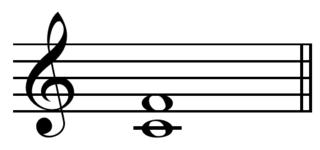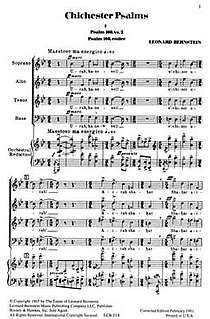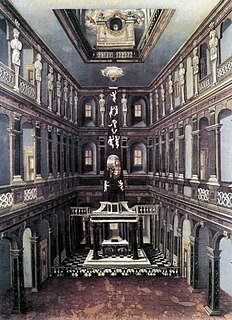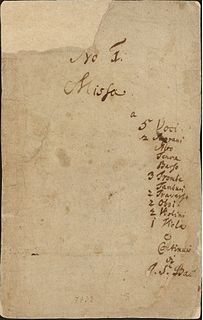Related Research Articles

A fourth is a musical interval encompassing four staff positions in the music notation of Western culture, and a perfect fourth is the fourth spanning five semitones. For example, the ascending interval from C to the next F is a perfect fourth, because the note F is the fifth semitone above C, and there are four staff positions between C and F. Diminished and augmented fourths span the same number of staff positions, but consist of a different number of semitones.

A madrigal is a secular vocal music composition of the Renaissance and early Baroque (1600–1750) eras. The polyphonic madrigal is unaccompanied, and the number of voices varies from two to eight, but usually features three to six voices, whilst the metre of the madrigal varies between two or three tercets, followed by one or two couplets. Unlike the verse-repeating strophic forms sung to the same music, most madrigals are through-composed, featuring different music for each stanza of lyrics, whereby the composer expresses the emotions contained in each line and in single words of the poem being sung.

Jacques Arcadelt was a Franco-Flemish composer of the Renaissance, active in both Italy and France, and principally known as a composer of secular vocal music. Although he also wrote sacred vocal music, he was one of the most famous of the early composers of madrigals; his first book of madrigals, published within a decade of the appearance of the earliest examples of the form, was the most widely printed collection of madrigals of the entire era. In addition to his work as a madrigalist, and distinguishing him from the other prominent early composers of madrigals – Philippe Verdelot and Costanzo Festa – he was equally prolific and adept at composing chansons, particularly late in his career when he lived in Paris.

Luca Marenzio was an Italian composer and singer of the late Renaissance.
Word painting, also known as tone painting or text painting, is the musical technique of composing music that reflects the literal meaning of a song's lyrics or story elements in programmatic music.
A broken chord is a chord broken into a sequence of notes. A broken chord may repeat some of the notes from the chord and span one or more octaves.

Chichester Psalms is an extended choral composition in three movements by Leonard Bernstein for boy treble or countertenor, choir and orchestra. The text was arranged by the composer from the Book of Psalms in the original Hebrew. Part 1 uses Psalms 100 and 108, Part 2 uses 2 and 23, and Part 3 uses 131 and 133. Bernstein scored the work for a reduced orchestra, but also made a version for an even smaller ensemble of organ, one harp, and percussion.

The Symphony of Psalms is a choral symphony in three movements composed by Igor Stravinsky in 1930 during his neoclassical period. The work was commissioned by Serge Koussevitzky to celebrate the 50th anniversary of the Boston Symphony Orchestra. The symphony derives its name from the use of Psalm texts in the choral parts.
A false relation is the name of a type of dissonance that sometimes occurs in polyphonic music, most commonly in vocal music of the Renaissance.

The Orgelbüchlein BWV 599−644 is a set of 46 chorale preludes for organ — one of them is given in two versions — by Johann Sebastian Bach. All but three were written between 1708 and 1717 when Bach served as organist to the ducal court in Weimar; the remainder and a short two-bar fragment came no earlier than 1726, after the composer’s appointment as cantor at the Thomasschule in Leipzig.
The Miserere, by Josquin des Prez, is a motet setting of Psalm 51 for five voices. He composed it while in the employ of Duke Ercole I d'Este in Ferrara, in 1503 or 1504. It was one of the most famous settings of that psalm of the entire Renaissance, was hugely influential in subsequent settings of the Penitential Psalms, and was itself probably inspired by the recent suffering and execution of the reformer Girolamo Savonarola.

Diatonic and chromatic are terms in music theory that are most often used to characterize scales, and are also applied to musical instruments, intervals, chords, notes, musical styles, and kinds of harmony. They are very often used as a pair, especially when applied to contrasting features of the common practice music of the period 1600–1900.

Te Deum is a setting of the Latin Te Deum text, also known as the Ambrosian Hymn attributed to Saints Ambrose, Augustine, and Hilary, by Estonian-born composer Arvo Pärt, commissioned by the Westdeutscher Rundfunk in Cologne, Germany, in 1984. Dedicated to the late Alfred Schlee of Universal Edition, the WDR Broadcast Choir premiered the Te Deum under the direction of conductor Dennis Russell Davies on January 19, 1985. The Te Deum plays an important role in the services of many Christian denominations, including the Paraklesis (Moleben) of Thanksgiving in the Eastern Orthodox Church. Because of the unusual instrumentation Pärt employs, his Te Deum is not suited for use within the Orthodox Church. It was recorded on the ECM New Series label in 1993 by the Estonian Philharmonic Chamber Choir and Tallinn Chamber Orchestra under the direction of Tõnu Kaljuste. The piece is approximately thirty minutes long.
Eye music describes graphical features of scores which when performed are unnoticeable by the listener.
The Love Songs of Hafiz is the name of two song cycles by Karol Szymanowski, Op. 24 with piano accompaniment, and Op. 26 with orchestral accompaniment. There are six songs in Op. 24, three of them orchestrated in Op. 26, and five additional songs, unique to Op. 26. They were composed in Vienna, Austria in 1911 and 1914, respectively. The works represent a transition between the first and second periods of the composer's style.

Pauline Duchambge née de Montet was a French pianist, singer, and composer.

The Mass in B minor is Johann Sebastian Bach's only setting of the complete Latin text of the Ordinarium missae. Towards the end of his life, mainly in 1748 and 1749, he finished composing new sections and compiling it into a complex, unified structure.

Tristis est anima mea is a sacred motet for five voices attributed to Johann Kuhnau, Thomaskantor in Leipzig. The text is the second responsory at Tenebrae for Maundy Thursday, one of the Latin texts kept in the liturgy after the town converted to Lutheranism.
O magnum mysterium (1569) is a six-part motet by Giovanni Pierluigi da Palestrina, based on the responsorial chant of the same name, and was written for the celebration of Christmas. The piece is intended to express the joy and awe that was felt by the shepherds as they celebrated and worshiped the Christ-child in the manger on Christmas Eve. Palestrina took the text for this piece from the first half of the third and fourth Responsories of Matins on Christmas Day. The text has been set many times by numerous composers, such as Palestrina, Poulenc, Lauridsen, and Morales.
Missa L'Homme armé is a part of a mass by Giovanni Pierluigi da Palestrina. It was published in 1570 and consists of four movements.